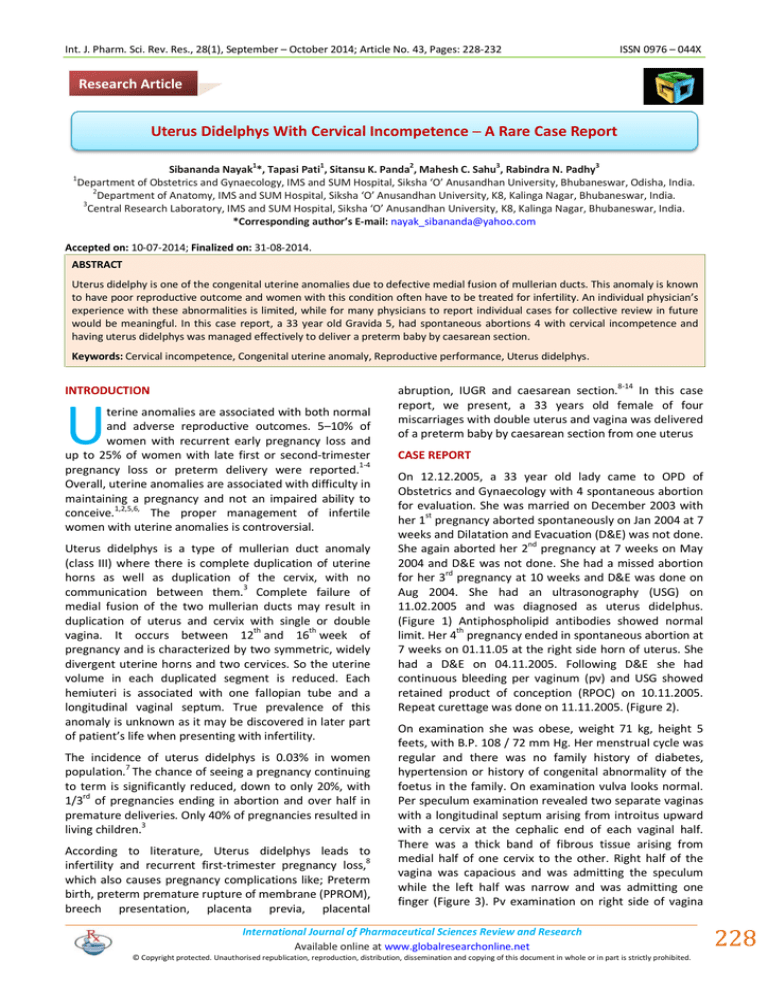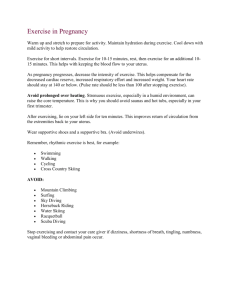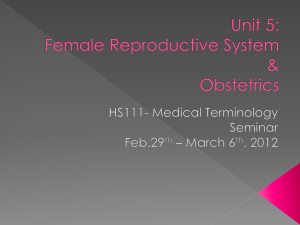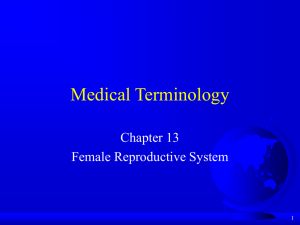Document 13310006
advertisement

Int. J. Pharm. Sci. Rev. Res., 28(1), September – October 2014; Article No. 43, Pages: 228-232 ISSN 0976 – 044X Research Article Uterus Didelphys With Cervical Incompetence ─ A Rare Case Report 1 1 1 2 3 3 Sibananda Nayak *, Tapasi Pati , Sitansu K. Panda , Mahesh C. Sahu , Rabindra N. Padhy Department of Obstetrics and Gynaecology, IMS and SUM Hospital, Siksha ‘O’ Anusandhan University, Bhubaneswar, Odisha, India. 2 Department of Anatomy, IMS and SUM Hospital, Siksha ‘O’ Anusandhan University, K8, Kalinga Nagar, Bhubaneswar, India. 3 Central Research Laboratory, IMS and SUM Hospital, Siksha ‘O’ Anusandhan University, K8, Kalinga Nagar, Bhubaneswar, India. *Corresponding author’s E-mail: nayak_sibananda@yahoo.com Accepted on: 10-07-2014; Finalized on: 31-08-2014. ABSTRACT Uterus didelphy is one of the congenital uterine anomalies due to defective medial fusion of mullerian ducts. This anomaly is known to have poor reproductive outcome and women with this condition often have to be treated for infertility. An individual physician’s experience with these abnormalities is limited, while for many physicians to report individual cases for collective review in future would be meaningful. In this case report, a 33 year old Gravida 5, had spontaneous abortions 4 with cervical incompetence and having uterus didelphys was managed effectively to deliver a preterm baby by caesarean section. Keywords: Cervical incompetence, Congenital uterine anomaly, Reproductive performance, Uterus didelphys. INTRODUCTION U terine anomalies are associated with both normal and adverse reproductive outcomes. 5–10% of women with recurrent early pregnancy loss and up to 25% of women with late first or second-trimester pregnancy loss or preterm delivery were reported.1-4 Overall, uterine anomalies are associated with difficulty in maintaining a pregnancy and not an impaired ability to conceive.1,2,5,6, The proper management of infertile women with uterine anomalies is controversial. Uterus didelphys is a type of mullerian duct anomaly (class III) where there is complete duplication of uterine horns as well as duplication of the cervix, with no communication between them.3 Complete failure of medial fusion of the two mullerian ducts may result in duplication of uterus and cervix with single or double vagina. It occurs between 12th and 16th week of pregnancy and is characterized by two symmetric, widely divergent uterine horns and two cervices. So the uterine volume in each duplicated segment is reduced. Each hemiuteri is associated with one fallopian tube and a longitudinal vaginal septum. True prevalence of this anomaly is unknown as it may be discovered in later part of patient’s life when presenting with infertility. The incidence of uterus didelphys is 0.03% in women 7 population. The chance of seeing a pregnancy continuing to term is significantly reduced, down to only 20%, with 1/3rd of pregnancies ending in abortion and over half in premature deliveries. Only 40% of pregnancies resulted in living children.3 According to literature, Uterus didelphys leads to infertility and recurrent first-trimester pregnancy loss,8 which also causes pregnancy complications like; Preterm birth, preterm premature rupture of membrane (PPROM), breech presentation, placenta previa, placental abruption, IUGR and caesarean section.8-14 In this case report, we present, a 33 years old female of four miscarriages with double uterus and vagina was delivered of a preterm baby by caesarean section from one uterus CASE REPORT On 12.12.2005, a 33 year old lady came to OPD of Obstetrics and Gynaecology with 4 spontaneous abortion for evaluation. She was married on December 2003 with her 1st pregnancy aborted spontaneously on Jan 2004 at 7 weeks and Dilatation and Evacuation (D&E) was not done. She again aborted her 2nd pregnancy at 7 weeks on May 2004 and D&E was not done. She had a missed abortion for her 3rd pregnancy at 10 weeks and D&E was done on Aug 2004. She had an ultrasonography (USG) on 11.02.2005 and was diagnosed as uterus didelphus. (Figure 1) Antiphospholipid antibodies showed normal limit. Her 4th pregnancy ended in spontaneous abortion at 7 weeks on 01.11.05 at the right side horn of uterus. She had a D&E on 04.11.2005. Following D&E she had continuous bleeding per vaginum (pv) and USG showed retained product of conception (RPOC) on 10.11.2005. Repeat curettage was done on 11.11.2005. (Figure 2). On examination she was obese, weight 71 kg, height 5 feets, with B.P. 108 / 72 mm Hg. Her menstrual cycle was regular and there was no family history of diabetes, hypertension or history of congenital abnormality of the foetus in the family. On examination vulva looks normal. Per speculum examination revealed two separate vaginas with a longitudinal septum arising from introitus upward with a cervix at the cephalic end of each vaginal half. There was a thick band of fibrous tissue arising from medial half of one cervix to the other. Right half of the vagina was capacious and was admitting the speculum while the left half was narrow and was admitting one finger (Figure 3). Pv examination on right side of vagina International Journal of Pharmaceutical Sciences Review and Research Available online at www.globalresearchonline.net © Copyright protected. Unauthorised republication, reproduction, distribution, dissemination and copying of this document in whole or in part is strictly prohibited. 228 © Copyright pro Int. J. Pharm. Sci. Rev. Res., 28(1), September – October 2014; Article No. 43, Pages: 228-232 ISSN 0976 – 044X showed bulky anteverted uterus while pv in left side showed normal size uterus. Investigations revealed, Haemoglobin 10.6 gm%, TLC 7200/mm3, random plasma glucose 87 mg/dl, chromosomal study of both husband and wife revealed normal chromosomal pattern (Fig 4 and Fig 5). She was advised to reduce weight and was started with folic acid 5 mg/day. On 7.03.2006 she reported for her 5th pregnancy with the complain of mild bleeding pv and her LMP was on 23.01.2006. USG showed a intrauterine gestational sac of 6 week at right horn of uterus and left horn was empty (Figure 6). Repeat ultrasound on 17.03.2006 showed active intrauterine foetus of size 7 weeks 4 days with no retro placental clot. She was advised complete bed rest and was prescribed with folic acid 5 mg tablet once daily, natural micronized progesterone 200 µg vaginal pessary twice daily and injection human chorionic gonadotrophin 5000 IU intramuscularly twice weekly. Injection human chorionic gonadotrophin was continued till 12 weeks of pregnancy and then discontinued. At 16 weeks and 2 days on 17.05.2006 she came to OPD with the complain of heaviness at lower abdomen and feeling of baby coming out of vagina. On examination uterus was 16 weeks size and irritable. Perspeculum examination showed 1cm long cervix per vaginum with the USG showing cervical length 2.0 cm. For that, Mc-Donald stitch was put on the cervix and sustained release tablet isoxsuprine hydrochloride 40 mg/day continued throughout the pregnancy. On 22.07.2006 at 25 weeks 5 day she complained of severe lower abdominal pain. Uterus was irritable and urine examination showed no abnormality. She was managed conservatively with oral nifedipine capsule 20 mg tid for 3 days. On 13.08.2006 at 28 weeks 5 days she was given with two doses of injection Betamethasone 12 mg every 12 hourly prophylactically and was repeated on 27.08.2006 at 30 weeks 5 days as the patient was complaining of pain abdomen and had slight bleeding pv. USG revealed placenta at upper segment with small retro placental clot. Hence she was advised absolute bed rest. Figure 1: Ultrasound image of Uterus didelphys On 26.09.2006 at 35 weeks 1 day she was admitted in hospital at 6 am with the complain of pain abdomen and decreased foetal movement. Her Mc-Donald stitch was removed and labour was assessed. 12 hours later due to irregular heart rate pattern of the foetus she was taken to the operating room where a lower segment caesarean section was done and a preterm female baby of Apgar score 9 and 10 at 1” and 5” respectively, weighing 2400 gm was delivered. During operation the pregnancy was in right horn of the uterus and left horn of the uterus was ill developed (Figure 7). Her postoperative course was th uneventful and she was discharged to home on 8 postoperative day with the infant. No complication was encountered with the baby and the mother during the last 7 years of follow up. In the mean time, she delivered her second live baby at 33 week by caesarean section on 12. 08.2010. The post partum period after the second issue was uneventful. Figure 2: Ultrasound image of RPOC at right horn of uterus International Journal of Pharmaceutical Sciences Review and Research Available online at www.globalresearchonline.net © Copyright protected. Unauthorised republication, reproduction, distribution, dissemination and copying of this document in whole or in part is strictly prohibited. 229 © Copyright pro Int. J. Pharm. Sci. Rev. Res., 28(1), September – October 2014; Article No. 43, Pages: 228-232 Figure 3: Pervaginal exam showing double vagina with a septum in between ISSN 0976 – 044X Figure 6: Ultrasound image of pregnant uterus at 6 weeks showing gestational sacs at right horn Figure 7: Caesarean section of the patient showing the pregnancy at right horn and left horn ill developed DISCUSSION Figure 4: Karyotype report of husband of the patient Figure 5: Karyotype report of the patient The failure of fusion of the two mullerian ducts results in duplication of mullerian structures; a didelphic uterus has two uteri, two endometrial cavities and two cervices. A longitudinal vaginal septum is present in 75 % cases.5 True prevalence of congenital uterine anomalies in population is not known, which varies from 0.1 to 5,6,9 10%. According to a report, the incidence of diagnosed uterine anomalies was close to 0.45 %, however the incidence of uterus didelphys was 24.2%,2 while others found a mean incidence of 11%.4,20 Congenital uterine anomalies are associated with higher incidence of reproductive failure and obstetric complications. Women with this form of congenital anomaly required infertility treatment more frequently than women with other uterine anomalies 2,16 and the overall reproductive 3 performance of uterus didelphys is poor. Others feel that didelphic uterus offers the best chance for a successful 9 17 pregnancy 57% with a fetal survival rate as high as 64%. Multifetal gestation is rare in women with uterus didelphys. There has also been a triplet pregnancy with uterus didelphys with 72 days lapse between the delivery 18 of the first two fetuses and the third. The presence of a International Journal of Pharmaceutical Sciences Review and Research Available online at www.globalresearchonline.net © Copyright protected. Unauthorised republication, reproduction, distribution, dissemination and copying of this document in whole or in part is strictly prohibited. 230 © Copyright pro Int. J. Pharm. Sci. Rev. Res., 28(1), September – October 2014; Article No. 43, Pages: 228-232 malformed uterus in a woman, impairs reproductive performance by increasing the incidence of early and late abortions, preterm deliveries as well as the rate of 13,17,18 obstetric complications. It was shown a mean 32.9 % abortion rate, a mean 28.9 % preterm delivery rate, a mean 36.2 % term delivery rate with a mean 56.6 % live birth rate in uterus didelphys.7 Uterine anomalies are associated with diminished uterine cavity size, insufficient musculature, impaired ability to distend, abnormal myometrial and cervical function, inadequate vascularity and abnormal endometrial development.7,19,20,21 These abnormalities of space, vascular supply and associated local defects contribute to increased rate of recurrent pregnancy loss and preterm delivery. 3,4 Our patient also had four recurrent abortions where no cause was found. It was found that the spontaneous abortion rate ranges from 32 to 52% and preterm birth rates from 20 to 45%. Recurrent pregnancy loss is due to decreased uterine volume and associated cervical incompetence. 22 Our patient had a cervical length of 2.0 cm at USG and in vaginal exam cervical length was 1 cm. According to a report, the cervical incompetence was 30% of mullerian anomaly. 23 With cervical encirclage or surgical correction, incidence of term pregnancies in the group with documented cervical incompetence increases from 26 to 63%. 24 Abnormal uterine blood flow and decreased muscle mass in uterus didelphys leads to IUGR of foetus.27 It is suggested that abnormal irregular contraction may lead to microablation of placenta leading to placental insufficiency and IUGR. Women with uterine didelphys accounted for higher proportion of preterm birth < 34 weeks and < 37 weeks than the control.7,28 According to the report 21% of pregnant women with didelphys uterus deliver prematurely.29 Our patient delivered at 35 weeks 1 day. Increased caesarean delivery rate is associated with higher rate of malpresentation and vaginal anomalies such as a longitudinal vaginal septum. According to the report, the highest caesarean section rate (82%) in 29 patients with uterus didelphys. Our patient had a ceserean section at 35 weeks 1 day due to irregular fetal heart rate pattern. Spontaneous vaginal delivery as well as caesarean section at term has been reported. CONCLUSION Didelphic uterus is a very rare anomaly and it can lead to recurrent pregnancy loss due to decreased uterine volume and associated cervical incompetence. Preterm birth rate is increased due to irregular uterine contraction. By adequate rest, tocolytics and cervical encirclage, a live baby can be awarded. Acknowledgement: The authors would like to thank President Prof. Manoj Ranjan Nayak and Managing member, Er. Gopabandhu Kar, Siksha ‘O’ Anusandhan University for extended facility. Mahesh C. Sahu is ISSN 0976 – 044X research associate of IMS and SUM Hospital, Siksha ‘O’ Anusandhan University, Bhubaneswar. REFERENCES 1. Acien P, Incidence of mullerian defects in fertile and infertile women, Hum Reprod, 12, 1997, 1372–1376. 2. Grimbizis GF, Camus M, Tarlatzis BC, et al., Clinical implications of uterine malformations and hysteroscopic treatment results, Hum Reprod Update, 7, 2001, 161–174. 3. Raga F, Bauset C, Remohi J, et al., Reproductive impact of congenital mullerian anomalies, Hum Reprod, 12, 1997, 2277–2281. 4. Simon C, Martinez L, Pardo F, et al., Mullerian defects in women with normal reproductive outcome, Fertil Steril, 56, 1991, 1192–1193. 5. Lin PC, Bhatnagar KP, Nettleton GS, Nakajima ST, Female genital anomalies affecting reproduction, Fertil Steril, 78, 2002, 899–915. 6. Kim TE, Lee GH, Choi YM, Jee BC, Ku SY, Suh CS, et al., Hysteroscopic resection of the vaginal septum in uterus didelphys with obstructed hemivagina: a case report, J Korean Med Sci, 22(4), 2007, 766-769. 7. Ahmad FK, Sherman SJ, Hagglund KH, Twin gestation in a woman with a uterus didelphys - A case report, J Reprod Med, 45(4), 2000, 357-359. 8. Reichman D, Lauger MR, Robinson BK, Pregnancy outcomes in unicornuate uteri: A review, Fertil Steril, 91, 2009, 18861894. 9. Zhang Y, Zhao Y, Qiao J, Obstetric outcome of women with uterine anomalies in China, Chin Med J, 123, 2010, 418422. 10. Akar ME, Bayar D, Yildiz S, et al., Reproductive outcome of women with unicornuate uterus, Aust N Z J Obstet Gynaecol, 45, 2005, 148-150. 11. Ben-Rafael Z, Seidman DS, Recabi K, et al., Uterine anomalies: a retrospective, matchedcontrol study, J Reprod Med, 36, 1991, 723-727. 12. Rackow BW, Arici A, Reproductive performance of women with mullerian anomalies, Curr Opin Obstet Gynecol, 19, 2007, 229-237. 13. Woelfer B, Salim R, Banerjee S, et al., Reproductive outcomes in women with congenital uterine anomalies detected by three-dimensional ultrasound screening, Obstet Gynecol, 98, 2001, 1099-103. 14. Pui M, Imaging diagnosis malformation, Computerized Graphics, 28, 2004, 425–433. of congenital uterine Medical Imaging and 15. Nahum GG, Uterine anomalies, How common are they, and what is their distribution among subtypes, J Reprod Med, 43, 1998, 877-887. 16. Musich JR, Behrman SJ, Obsteric outcome before and after metroplasty in women with uterine anomalies, Obstet Gynecol, 52, 1978, 63. 17. Heinohen PK, Saarikoski S, Pystynen P, Reproductive performance of women with uterine anomalies, Acta Obstet gynecol Scand, 61, 1982, 157. International Journal of Pharmaceutical Sciences Review and Research Available online at www.globalresearchonline.net © Copyright protected. Unauthorised republication, reproduction, distribution, dissemination and copying of this document in whole or in part is strictly prohibited. 231 © Copyright pro Int. J. Pharm. Sci. Rev. Res., 28(1), September – October 2014; Article No. 43, Pages: 228-232 18. Mashiach S, Ben-Rafael Z, Dor J, Serr DM, Triplet pregnancy in uterus didelphys with delivery interval of 72 days, Obstet Gynecol, 58, 1981, 519-521. 19. Kekkonen R, Nuutila M, Laatikainen T, Twin pregnancy with a fetus in each half of a uterus didelphys, Acta Obstet Gynecol Scand, 70, 1991, 373-374. 20. Nhan VQ, Huisjes HJ, Double uterus with a pregnancy in each half, Obstet Gynecol, 61, 1983, 115-117. 21. Lewenthal H, Biale Y, Ben-Adereth N, Uterus didelphys with a pregnancy in each horn. Case report, Br J Obstet Gynaecol, 84, 1977, 155-158. 22. Aher GS , Gavali Urmila G, Kulkarni Meghana, Uterine didelphys with cervical incompetence, Int J Med Res Health Sci, 2, 2013, 281-283. 23. Golan A, Langer R, Wexler S, et al., Cervical cerclage: Its role in pregnant anomalous uterus, Int J Fertil, 35, 1990, 164-170. 24. Heinonen PK, Reproductive performance of women with uterine anomalies after abdominal or hysteroscopic ISSN 0976 – 044X metroplasty or no surgical treatment, J Am Assoc Gynecol Laparose, 4, 1997, 311-317. 25. Andrews MC, Jones HWJ, Impaired reproductive performance of the unicornuate uterus: Intrauterine growth retardation, infertility and recurrent abortion in five cases, Am J Obstet Gynecol, 144, 1982, 173-176. 26. Moutos D, Damewood M, Schlaff W, et al., A comparison of the reproductive outcome between women with a unicornuate uterus and women with a didelphic uterus, Fertil Steril, 58, 1992, 88-93. 27. Blum M. comparative study of serum CAP activity during pregnancy in normal and malformed uterus, Perinat Med, 6, 1978, 165-168. 28. Hua M, Odibo AO, Longman RE, et al., Congenital uterine anomalies and adverse pregnancy outcomes, Am J Obstet Gynecol, 205, 2011, 558 e 1-5. 29. Heinonen PK, R J Obstet Gynecol Reprod Biol, 17, 1984, 345-350. Source of Support: Nil, Conflict of Interest: None. International Journal of Pharmaceutical Sciences Review and Research Available online at www.globalresearchonline.net © Copyright protected. Unauthorised republication, reproduction, distribution, dissemination and copying of this document in whole or in part is strictly prohibited. 232 © Copyright pro






